Upon purchasing an e-bicycle, a pleasant hassle of running it in and equipping it with useful accessories follows. Most bike accessories are not part of the basic package. Manufacturers do not impose a set of random accessories on buyers, instead, they allow each cyclist to equip the bike with only necessary items, selected according to their own perception of comfort and safety during rides. As a result, amidst an abundance of useful add-ons, one can choose the most essential bike accessories and customize the bike "for oneself," taking into account personal preferences without unnecessary expenditures.
What kinds of accessories are important for bikes?
All bike accessories are divided into 2 categories:
- Essentials – these are purchased primarily as they are very important. Lack of such accessories increases the risk of injury and reduces the comfort of rides.
- Optional but desirable additions – they make riding more comfortable, lend a charismatic look to the bike, and solve other problems.
In our review, we present the most essential bike accessories that should be purchased first and taken on every ride.
Pump
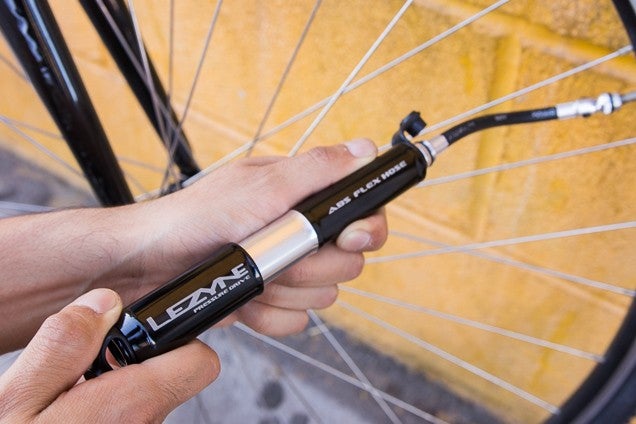
photo by Kyle Fitzgerald
It is essential to maintain the correct tire pressure. Deflated tires are only good for fat bikes, while for other bicycles they are not advisable. It's desirable for every cyclist to have two pumps:
- Portable hand bike pump for trips - lightweight and compact, it can easily fit in a backpack, pocket, or on the frame.
- Stationary floor bike pump, allowing quick inflation of tires to high pressure - for home use
Why its necessary to have
-
Maintaining Optimal Tire Pressure: Bike tires naturally lose air over time. Riding with the correct tire pressure ensures the best performance and efficiency of your bike. Under-inflated tires can make pedaling harder, reduce your speed, and increase the risk of punctures.
-
Dealing with Punctures: If you get a flat tire while riding, a pump is essential for re-inflating the tire after you've repaired or replaced the inner tube. Without a pump, a flat tire could leave you stranded far from help.
-
Adjusting Tire Pressure for Different Conditions: In certain riding conditions, you might want to adjust your tire pressure. For example, lower pressure can provide better grip in wet or off-road conditions. A pump allows you to make these adjustments on the go.
-
Emergency Assistance: Carrying a pump can not only help you but also other cyclists who might be in need. It's a basic but valuable tool for any cyclist to carry.
-
Longevity of Tires: Properly inflated tires wear out less quickly than under-inflated ones. Consistent tire pressure maintenance can extend the life of your bike tires.
How to choose the right one
-
Valve Compatibility: Ensure the pump fits your eBike's valve type (Presta or Schrader).
-
Pressure Capacity: Choose a pump that can easily reach your tire's recommended pressure.
-
Pump Types:
- Floor Pump: Best for home use, efficient, often with a pressure gauge.
- Hand Pump: Portable, for on-the-go use, more manual effort required.
- CO2 Inflator: Compact, for quick inflation, single-use.
- Electric Pump: Quick, effortless inflation, ideal for frequent use.
-
Pressure Gauge: Opt for a pump with a built-in gauge for accurate inflation.
-
Size and Portability: Consider the pump's size and portability based on your usage needs.
Multi-tool
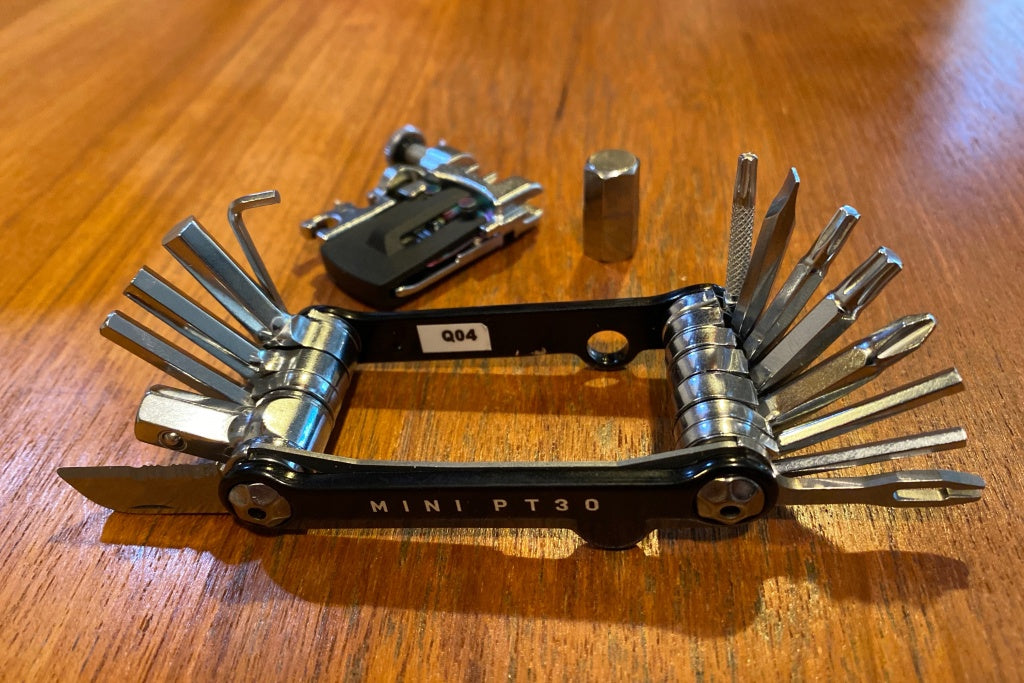
photo by outdoorgearlab
A compact multi-tool is a useful item for every cyclist. A foldable set of hex keys won’t take up much space and will come in handy whenever something needs adjusting or tightening - starting from the bike assembly stage and continuing with its regular maintenance. With its help, you can raise the saddle, adjust the handlebars, perform minor repairs, or attach additional accessories.
Each of these accessories is designed to ensure that cyclists can manage basic maintenance tasks, ensuring a smooth and safe ride every time. They also enable cyclists to customize their bikes to a great extent, according to personal preferences, ensuring both functionality and aesthetic appeal.
Why its necessary to have
-
On-the-Go Adjustments: E-bikes, like traditional bicycles, may require minor adjustments during a ride. This could include tightening bolts, adjusting the seat height, or aligning the handlebars. A multi-tool provides the necessary tools for these adjustments.
-
Emergency Repairs: In case of mechanical issues, such as a loose chain, brake adjustments, or other small repairs, a multi-tool can be a ride-saver. Without it, you might be stranded or forced to walk your bike for long distances.
-
Electrical Connections: E-bikes have electrical components that may occasionally require attention, such as battery terminals or motor connections. Some multi-tools include features suitable for simple electrical adjustments or checks.
-
Versatility: Multi-tools are designed to be compact and lightweight, yet they include a variety of tools like hex wrenches, screwdrivers, and sometimes even chain tools. This versatility is incredibly useful given the wide range of potential needs during a bike ride.
-
Independence: Having a multi-tool empowers you to handle common issues independently, without needing to seek out a bike shop or assistance from others.
-
Cost-Effective Maintenance: Performing minor adjustments and repairs yourself can save money on maintenance costs.
How to choose the right one
-
Essential Tools: Ensure it includes Allen keys, screwdrivers, and a chain tool.
-
Compatibility: Check if the toolset matches your eBike's specific requirements.
-
Quality and Durability: Opt for robust, rust-resistant materials.
-
Portability: Choose a lightweight, compact design for easy carrying.
-
Ease of Use: Look for ergonomic designs for comfortable handling.
-
Additional Features: Consider added functionalities like tire levers or spoke wrenches.
Spare Tube and Tire Levers
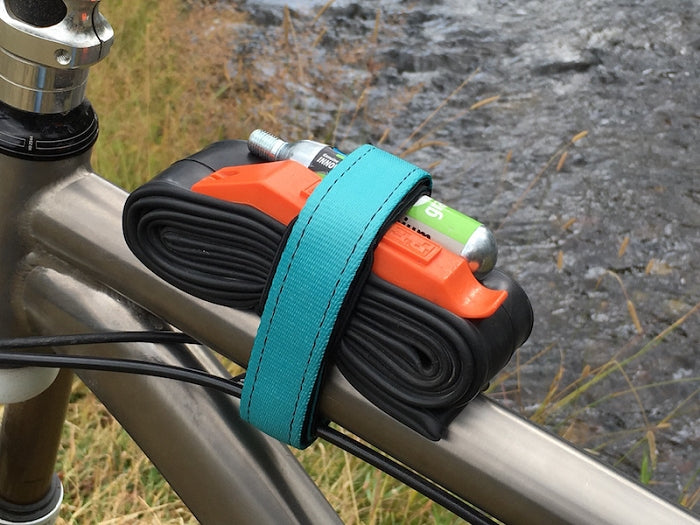
photo by universalcycles
In the event of a puncture, you can replace the damaged tube and continue your ride if you don’t forget to take along a spare and a portable pump. When folded, a bicycle tube is compact, so it will easily fit in a bike bag or backpack. Plastic tire levers will help to remove the tire — a small tool that makes the unseating and seating of the wheel much easier.
Why its necessary to have
-
Puncture Repair: The most common issue cyclists face is a punctured tire. Having a spare tube means you can replace a tube that's been damaged beyond repair. Without a spare, a puncture could end your ride prematurely.
-
E-bikes are Heavier: E-bikes are generally heavier than traditional bikes due to their motor and battery. This extra weight can increase the likelihood of punctures. Therefore, being prepared with a spare tube is even more crucial.
-
Time and Convenience: Fixing a puncture by replacing the tube is often quicker and easier than trying to patch a hole, especially if you are on the roadside or trail.
-
Tire Levers for Removal and Fitting: Tire levers are essential tools for removing the tire from the rim to access the tube. They are also helpful in fitting the tire back onto the rim after the tube has been replaced or repaired.
-
Reduced Accessibility to Bike Shops or Help: Depending on where you’re riding, you may not have easy access to a bike shop or roadside assistance. Carrying a spare tube and levers ensures you can get yourself back on the road.
-
Safety: Being stranded with a flat tire in a remote area or having to walk a heavy e-bike back to civilization can be unsafe and challenging. A spare tube and levers can prevent this.
-
E-bike Specific Tubes: E-bike tires may have specific requirements for tubes due to their size, valve type, or thickness. Having the correct spare tube for your e-bike is essential.
How to choose the right one
-
Tube Size and Valve Type: Match the tube size with your tire size and choose the correct valve type (Presta or Schrader) as per your eBike's wheels.
-
Tube Material: Standard rubber tubes are common, but consider puncture-resistant tubes for added durability.
-
Tire Levers: Opt for sturdy, non-bending materials like reinforced plastic or metal. Avoid overly sharp edges to prevent tire damage.
-
Lever Size: Choose a size that offers good leverage but still fits easily in your repair kit or bag.
-
Packaging and Portability: Compact, lightweight designs are preferable for easy transport.
Bike Repair Kit
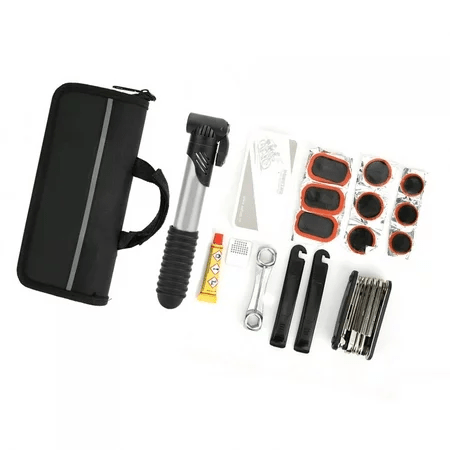
photo by walmart
In addition to a spare tube, it's advisable to have a bike repair kit on your ride — a set of patches and glue, with which you can repair a punctured tube at home or on the road. For this, you'll need to remove the wheel, unseat it using plastic tire levers, find and patch the puncture site. After a minute-long fixation of the patch, you can reassemble the wheel and continue your ride. But sometimes the damage is not patchable, and the tube requires a full replacement. Therefore, prudent cyclists take both a bike repair kit and a spare tube on rides.
Each of these tools and accessories are meant to help cyclists manage common issues that can occur during a ride, ensuring that a small problem like a puncture doesn’t end the ride prematurely. With these items, cyclists can ride with a bit more peace of mind, knowing they have the tools on hand to manage basic repairs.
Why its necessary to have
-
Self-Sufficiency: E-bikes, due to their mechanical and electrical components, can encounter a range of issues. A repair kit equips you to address minor problems independently, without needing immediate professional help.
-
Dealing with Common Issues: Flat tires, loose bolts, and misaligned parts are common issues in cycling. A repair kit typically contains tools and materials like patches, a multi-tool, a spare tube, and tire levers, allowing you to handle these situations.
-
E-Bike Specific Needs: E-bikes have unique components like electrical connectors and heavier frames. Some repair kits are designed specifically for e-bikes, with tools suited for these specialized needs.
-
Prevent Stranding: Given the added weight and complexity of e-bikes, being stranded due to a mechanical failure can be more challenging than with a regular bike. A repair kit helps ensure that minor issues don't leave you stranded.
-
Maintaining the E-Bike's Performance: Regular adjustments and minor repairs can keep your e-bike running smoothly, enhancing its performance and lifespan.
-
Cost-Effective: Handling minor repairs yourself can save money in the long run by avoiding frequent trips to the bike shop for small issues.
-
Safety: Properly maintained bikes are safer to ride. A repair kit helps you keep your bike in good condition, reducing the risk of accidents caused by equipment failure.
How to choose the right one
-
Basic Tools: Ensure it includes Allen keys, screwdrivers, a chain breaker, and wrenches compatible with your eBike.
-
Puncture Repair: Include tire levers, patches, a spare tube, and a mini pump or CO2 inflator.
-
Quality: Opt for durable, reliable tools that can withstand regular use.
-
Compactness and Portability: The kit should be lightweight and compact for easy carrying.
-
Additional Items: Consider including a multitool, emergency lights, and zip ties.
-
Storage: A small, durable bag or case to keep everything organized is beneficial.
Bicycle Lights
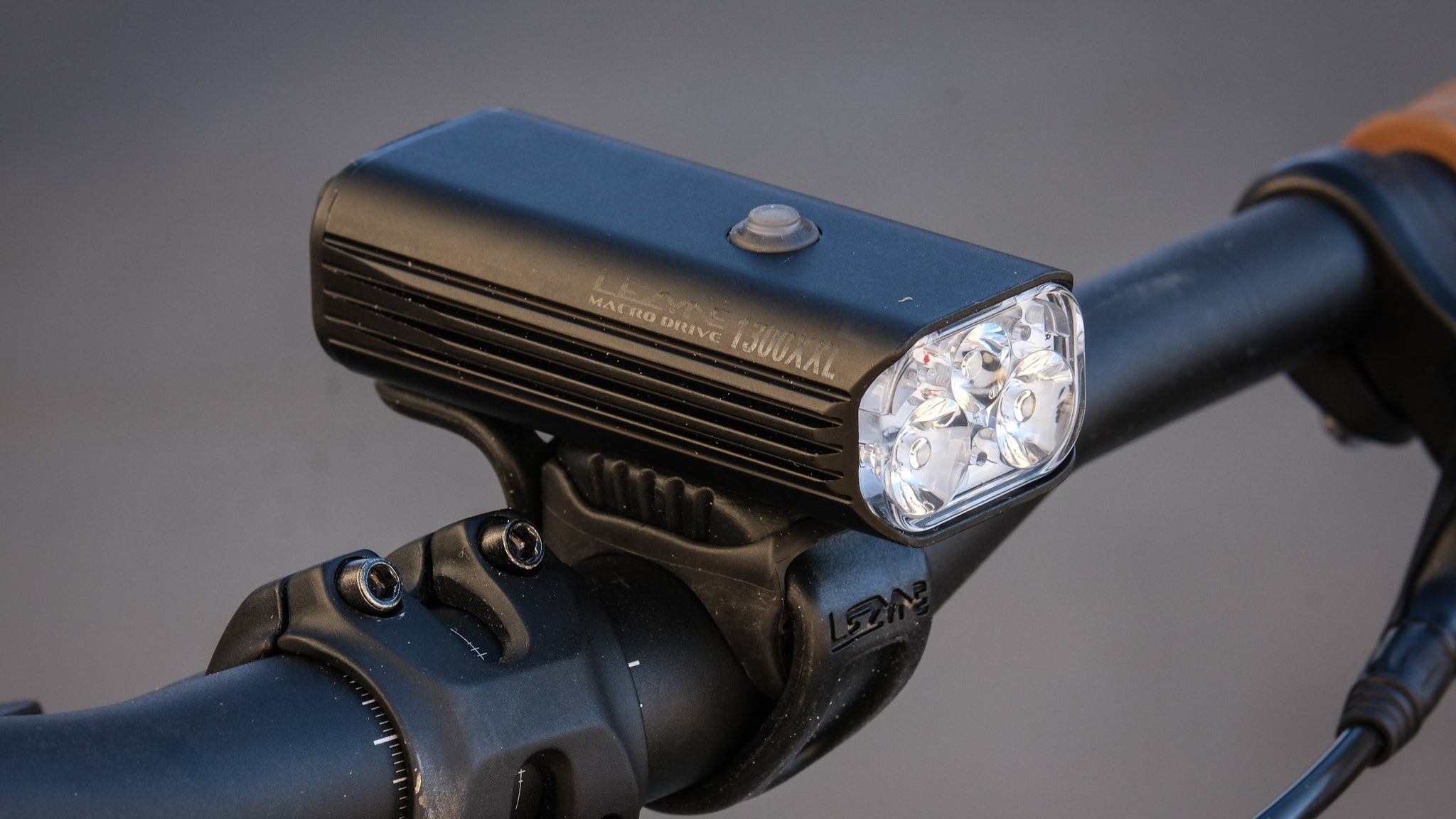
photo by tomsguide
For safe rides during dark hours, it's essential to equip your bicycle with a white light or headlamp at the front and a red light at the back. Bicycle lights illuminate the road, help to spot a pothole or an unexpected obstacle on time, and make your bike more visible to other road users. Choose lights with sufficiently bright illumination and a flashing feature.
Why its necessary to have
-
Visibility: Lights significantly increase your visibility to other road users, including drivers, pedestrians, and other cyclists. This is crucial both during the night and in low-light conditions such as fog, rain, or dusk.
-
Legal Requirements: In many regions, it's legally required to have lights on a bicycle when riding after dark. This typically includes a white light at the front and a red light at the rear.
-
Safety: Proper lighting helps you see the road ahead, identify potential hazards, and avoid obstacles. It's especially important when riding an e-bike, as they can travel at higher speeds compared to regular bikes.
-
Signal Intentions: Some bicycle lights come with additional features like blinking or varying intensities, which can be used to signal your presence and intentions to others, enhancing safety.
-
E-Bike Specific Considerations: E-bikes often travel faster than regular bikes, reducing others' reaction time. Bright lights help in compensating for this by making you noticeable sooner.
-
Enhanced Riding Experience: With good lighting, you can confidently ride in a wider range of conditions and times, extending your e-bike's utility beyond daylight hours.
-
Emergency Situations: In case of an emergency or unexpected situation, lights can be used to signal for help or to make yourself visible to rescuers.
How to choose the right one
-
Brightness and Beam Pattern: Ensure the front light is bright enough for visibility and has a beam pattern suitable for your riding environment.
-
Battery Life: Look for lights with a long-lasting battery, especially if you plan long rides or frequent use.
-
Mounting System: The lights should easily mount to your eBike and remain secure during rides.
-
Visibility: Rear lights should have a wide visibility angle for safety.
-
Durability and Weather Resistance: Opt for lights that are durable and weatherproof, especially if you ride in various conditions.
-
Modes and Adjustability: Multiple modes (steady, flashing) can be useful for different riding situations.
-
Rechargeability: Consider USB-rechargeable lights for convenience and cost-effectiveness.
Chain Lubricants
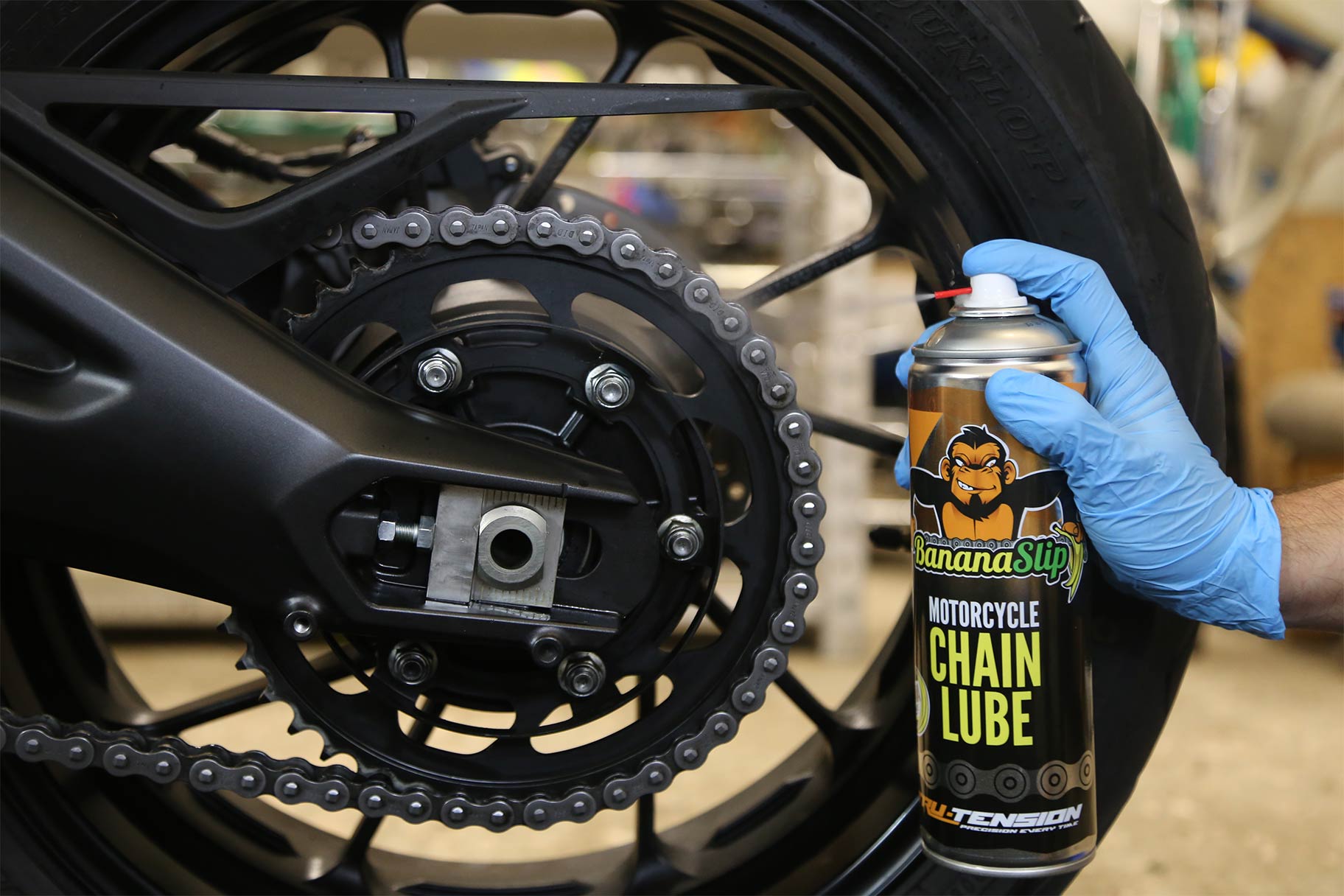
photo by true-tension
Special lubricant, along with a cleaner and cleaning machine, are necessary for chain maintenance. It's recommended to clean and lubricate the chain every 100-150 km of mileage, although much depends on the riding conditions. Regular transmission maintenance ensures its smooth operation, prolongs its lifespan, and allows for pedaling without extra effort.
These accessories are essential in maintaining the bicycle's functionality and ensuring the safety and comfort of the rider during both day and night time rides. By selecting high-quality lights and regularly maintaining the chain, cyclists can enjoy smoother, safer rides regardless of the time or weather conditions.
Why its necessary to have
-
Reducing Wear and Tear: E-bike chains undergo more stress due to the additional force exerted by the motor. Proper lubrication reduces friction and wear on the chain, sprockets, and derailleur, prolonging their life.
-
Enhancing Performance: A well-lubricated chain operates more smoothly, improving the overall efficiency of your e-bike. This means less resistance and effort when pedaling, leading to a better riding experience.
-
Preventing Rust and Corrosion: Lubricants protect the chain and other metallic components from rust and corrosion, especially if you're riding in wet or humid conditions.
-
Reducing Noise: A lubricated chain is quieter. E-bikes are generally more silent than traditional bikes, so reducing chain noise can make for a more enjoyable and less disruptive ride.
-
Maintaining Chain Health: Regular lubrication keeps the chain flexible and prevents it from becoming brittle and prone to breaking.
-
Ease of Cleaning: A lubricated chain is easier to clean. Dirt and debris adhere less to a lubricated chain and can be removed more easily, maintaining optimal performance.
-
Adapting to Different Conditions: Different lubricants are suited for different riding conditions (wet, dry, dusty). Using the right lubricant for your environment can significantly improve chain performance and lifespan.
How to choose the right one
-
Riding Conditions:
- Wet Lubricants: Best for wet, muddy conditions, as they are more water-resistant.
- Dry Lubricants: Ideal for dry conditions, as they attract less dirt and dust.
-
Lubricant Type:
- Wax-based: Good for clean, dry environments; requires more frequent application.
- Oil-based: Better for a range of conditions; longer lasting.
-
Application Frequency: Consider how often you are willing to reapply the lubricant. Dry lubes generally require more frequent application than wet lubes.
-
Compatibility with eBike: Ensure the lubricant is suitable for eBike chains, especially if your bike has any specific requirements.
-
Ease of Application: Look for a lubricant that is easy to apply with a precise applicator to avoid wastage and mess.
-
Eco-Friendliness: If preferred, choose environmentally friendly options.
Bike Bag
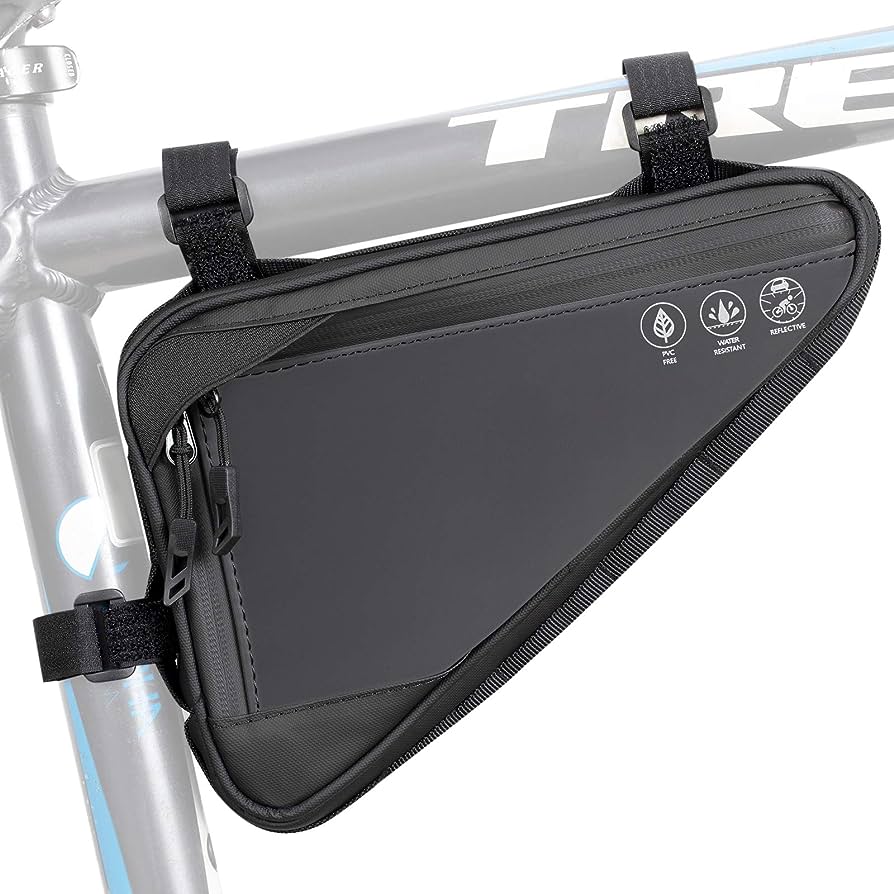
photo by amazon
A specialized bag is excellent for carrying bike accessories – it can be attached to the frame, handlebar, or under the seat. Saddle bags are more compact, while frame bags allow for carrying larger items, including clothing and shoes.
Why its necessary to have
-
Carrying Essentials and Tools: A bike bag allows you to carry essential items like a repair kit, spare tube, pump, multi-tool, and chain lubricants. These items are crucial for dealing with common mechanical issues or adjustments during your ride.
-
Storing Personal Items: It provides a convenient place to store personal items such as your wallet, keys, mobile phone, and snacks, keeping them safe and accessible while you ride.
-
E-Bike Specific Needs: E-bikes often require specific tools or accessories (like a battery charger or additional battery). A bike bag offers a secure way to carry these e-bike-specific items.
-
Protection from Weather: Many bike bags are made with weather-resistant materials, protecting your belongings from rain, dust, or mud.
-
Convenience: Having a dedicated bike bag means you're always ready to go, with all your cycling essentials packed and organized in one place.
-
Safety: Keeping items in a bike bag instead of your pockets can be safer, especially in case of a fall, as it reduces the risk of injury from items in your pockets.
-
Enhancing Long Rides: For longer rides or commutes, a bike bag is invaluable for carrying extra clothing, hydration packs, or food.
-
Versatility: Bike bags come in various forms (like frame bags, saddle bags, or handlebar bags), each offering different capacities and mounting options to suit various needs and bike types.
How to choose the right one
-
Capacity and Size: Ensure the bag is large enough to carry your essentials, but not so large that it becomes cumbersome.
-
Compatibility with Your eBike: Check that the bag fits well with your eBike’s frame and doesn’t interfere with its operation.
-
Mounting System: Look for a secure and easy-to-use mounting system that is compatible with your eBike.
-
Water Resistance: Consider a water-resistant or waterproof bag if you'll be riding in varied weather conditions.
-
Durability: Opt for a bag made of tough, long-lasting materials to withstand regular use.
-
Accessibility: Choose a bag with easy access to your items while you are riding.
-
Reflective Elements and Safety Features: For visibility and safety, especially if you ride in low-light conditions.
-
Type of Bag: Decide between panniers, frame bags, saddle bags, or handlebar bags based on your storage needs and riding style.
Bike Lock
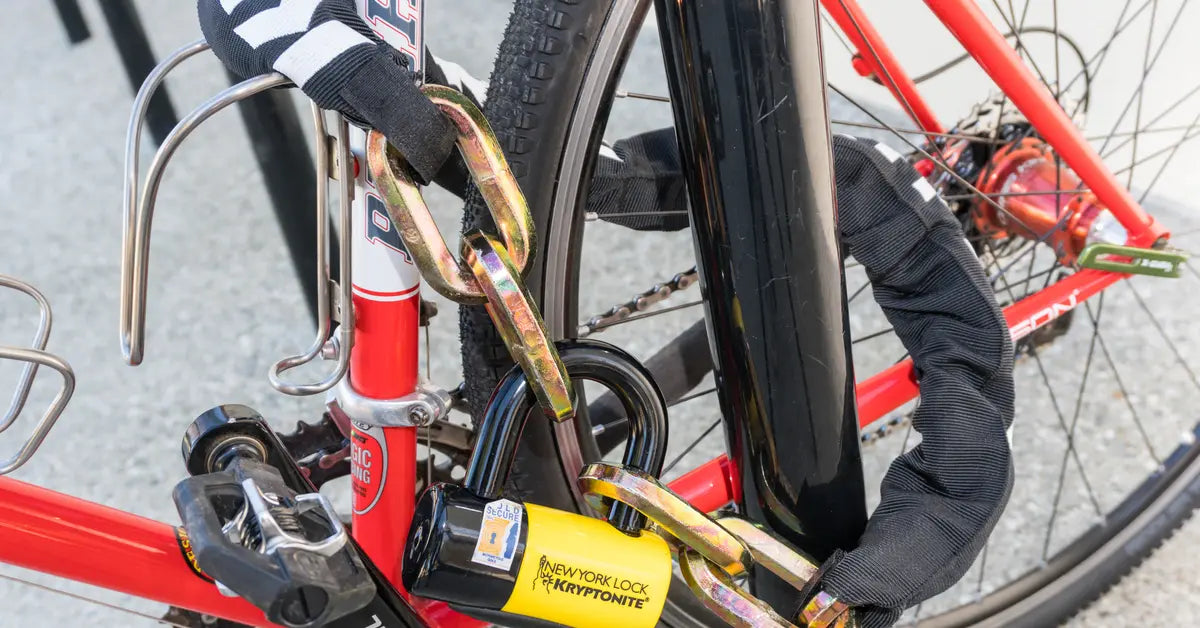
photo by nytimes
This accessory is essential for every cyclist who occasionally leaves their bike outside, for instance, at a store, cafe, hairdresser, or near the workplace. Even if you're leaving your bike for just a few minutes, it's wise not to tempt thieves with an easy target. The variety of bike locks available allows you to choose the optimal way to protect your bike from theft and avoid unfortunate incidents.
Why its necessary to have
-
Theft Prevention: E-bikes are valuable and, due to their cost and popularity, can be targets for theft. A robust bike lock is your first line of defense against potential thieves, especially when you need to leave your e-bike unattended, even for short periods.
-
Insurance Requirements: Some insurance policies for e-bikes might require the use of a lock when the e-bike is parked in public. Failing to use a lock can void insurance claims in case of theft.
-
Peace of Mind: Knowing your e-bike is secured with a lock provides peace of mind when you need to park it outside, allowing you to focus on your errands or activities without constant worry about the security of your bike.
-
High Resale Value of E-bikes: E-bikes typically have a higher resale value than traditional bikes, making them more attractive to thieves. A good lock can deter theft and protect your investment.
-
Locks Tailored to Risk Levels: Bike locks come in various types (e.g., U-locks, chain locks, folding locks) offering different levels of security. You can choose one that suits the level of risk in the areas where you typically park.
-
Convenience: Some bike locks are designed with features that offer convenience, such as combination locks (eliminating the need for keys) or lightweight materials for ease of transport.
-
Legal Requirement in Some Areas: In certain jurisdictions, locking up your bike in public spaces is mandated by law.
-
Multi-Lock Usage: For added security, especially in high-risk areas, using more than one lock (of different types) can be an effective deterrent against theft.
How to choose the right one
-
Lock Type:
- U-Locks: Offer high security; best for high-risk areas.
- Chain Locks: Flexible and good for securing to different objects.
- Folding Locks: Compact and easy to transport.
- Cable Locks: Lightweight, less secure, better for low-risk areas.
-
Security Level: Look for locks with a high security rating, especially if you often park in public or high-risk areas.
-
Material and Build Quality: Opt for locks made of hardened steel or other robust materials that resist cutting and breaking.
-
Lock Size and Weight: Ensure the lock is large enough to secure your bike to a solid object but not so heavy that it's inconvenient to carry.
-
Portability: Consider how you will carry the lock on your eBike. Some locks come with mounting brackets.
-
Key or Combination: Decide between a key lock (potentially more secure) or a combination lock (no key to lose).
-
Additional Features: Some locks offer extra features like alarm systems or are covered in material to prevent scratching your bike.
Smartphone Holder
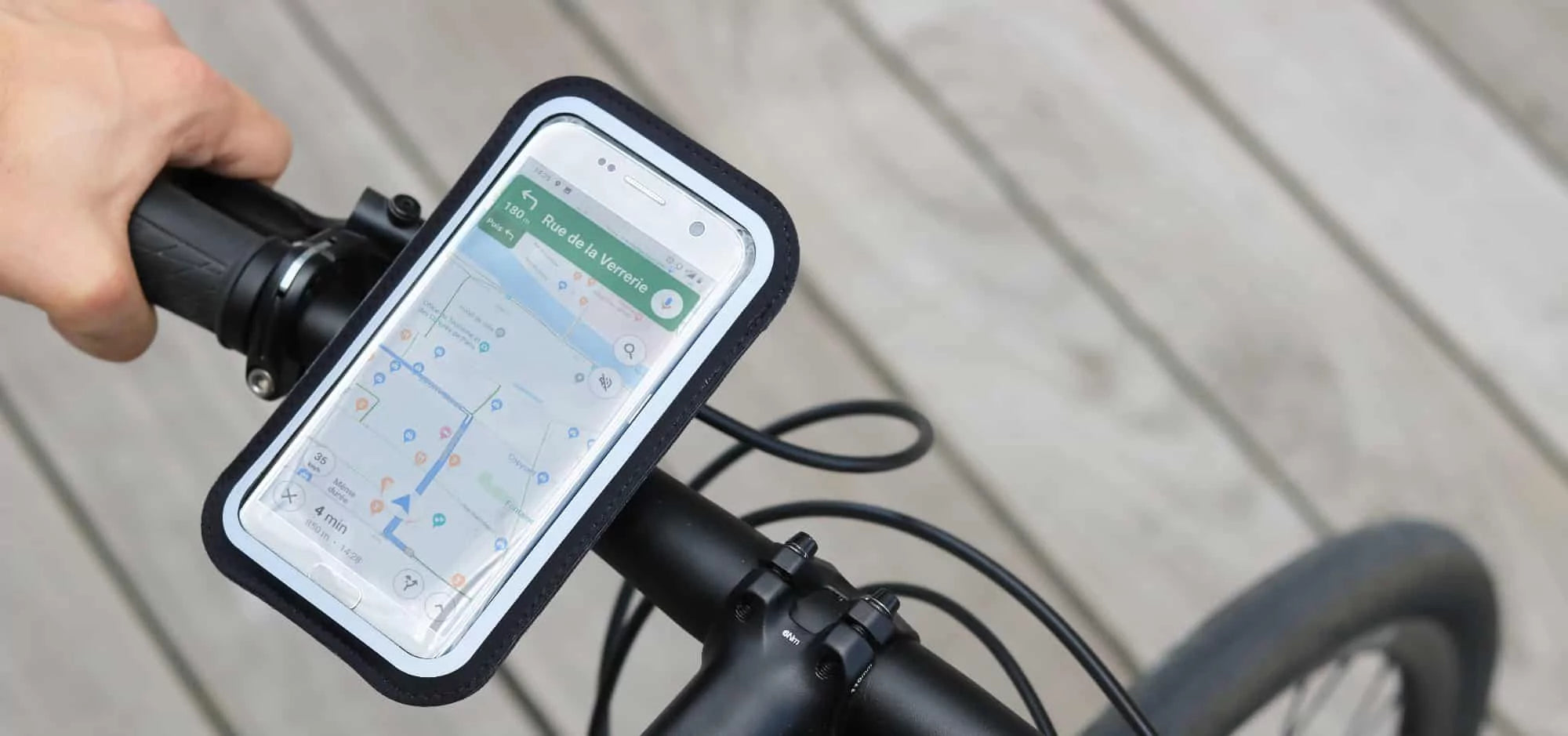
photo by pemamall
Instead of a bike computer, you can use a smartphone with special applications for cyclists. For a convenient and safe placement of the smartphone on the handlebar, use a special holder.
Why its necessary to have
-
Navigation: A smartphone holder allows you to easily use your phone’s GPS navigation features while riding, helping you find your way, especially in unfamiliar areas.
-
Safety: It’s much safer to glance at a phone in a holder for directions or information than to hold it in your hand, which can compromise your control over the bike.
-
Accessibility: A smartphone holder keeps your phone within easy reach, allowing you to quickly access apps, view performance metrics, or control music without stopping.
-
Tracking Rides: If you use fitness or cycling apps to track your rides, a smartphone holder makes it easier to monitor your progress in real time.
-
Emergency Use: In case of an emergency, having your smartphone readily accessible can be crucial for calling for help or using safety apps.
-
Hands-Free Compliance: Many regions have laws against using a handheld phone while cycling. A holder keeps you compliant with these regulations.
-
Protection: A good smartphone holder secures your phone, protecting it from falling out of your pocket and getting damaged during the ride.
-
E-Bike Compatibility: Some e-bike systems can connect to your smartphone for additional functionalities like battery status, route tracking, and system diagnostics, which can be conveniently monitored with a phone holder.
How to choose the right one
-
Compatibility with Phone Size: Ensure the holder can accommodate the size of your smartphone, with or without a case.
-
Mounting Style:
- Handlebar Mount: Common and stable, but ensure it fits your eBike's handlebar diameter.
- Stem Mount: Offers a central view; check compatibility with your eBike’s stem.
-
Stability and Security: The holder should firmly grip your phone, even on rough terrain, preventing it from shaking or falling out.
-
Ease of Use: Look for a holder that allows easy insertion and removal of the smartphone.
-
Adjustability: Ability to rotate or tilt for optimal viewing angle.
-
Vibration Dampening: Some holders include dampening to protect your phone from vibrations.
-
Durability and Weather Resistance: Opt for a durable material, and consider water-resistant features for riding in different weather conditions.
-
Aesthetic and Design: Choose a design that matches your preferences and doesn't interfere with the bike's functionality.
Bottle Holder or Mount
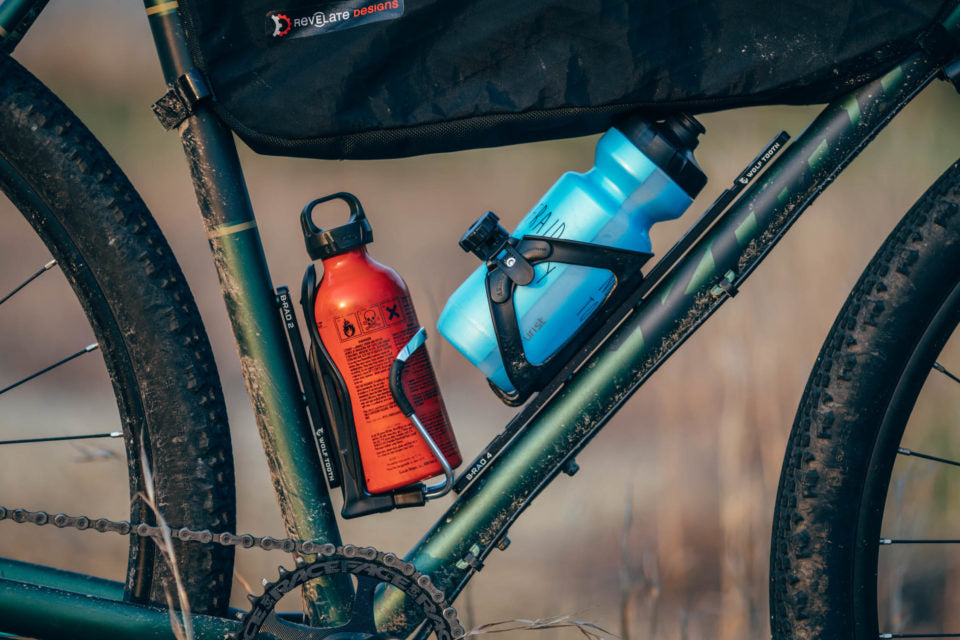
photo by bikepacking
A flask or a bottle of water is a must-have companion for a cyclist. It's necessary to avoid dehydration and maintain a good feeling during rides. Lack of moisture in the body harms the condition of the knee joints and more. Although it's possible to carry a flask or water bottle in a backpack, it's more convenient to place it on the frame with a special holder or mount.
Why its necessary to have
-
Hydration: The most obvious reason is to keep hydrated. Cycling, especially over long distances or in warm weather, can be physically demanding, and staying hydrated is crucial for maintaining performance and avoiding dehydration.
-
Convenience: A bottle holder allows for easy access to your drink without having to stop or reach into a bag. This is especially useful on longer rides or when cycling in areas where it might not be easy to stop and retrieve a water bottle.
-
Safety: Reaching for a bottle in a bag or backpack while riding can be distracting and potentially dangerous. A bottle holder allows you to grab and replace your bottle with minimal distraction from the road or trail.
-
Encourages Drinking: Having a water bottle visibly at hand encourages more frequent hydration, which is vital for maintaining physical performance and overall health during a ride.
-
Weight Distribution: Properly placed bottle holders can help evenly distribute weight on the bike, which can be important for maintaining balance, especially on an e-bike which is heavier due to its motor and battery.
-
E-bike Specific Design: Some e-bikes might not have a traditional frame design, making it challenging to find a place for a water bottle. A specially designed bottle holder or mount can solve this issue.
-
Aesthetics and Customization: Bottle holders come in various designs and colors, allowing riders to personalize their e-bike and enhance its aesthetic appeal.
How to choose the right one
-
Compatibility with Bike Frame: Ensure the holder fits your eBike's frame size and shape.
-
Material:
- Plastic or Polycarbonate: Lightweight and affordable.
- Metal (like Aluminum): Durable and often more secure, but heavier.
-
Ease of Bottle Access: Choose a design that allows easy insertion and removal of the bottle while riding.
-
Bottle Security: The holder should grip the bottle snugly, preventing it from falling out on rough terrains.
-
Mounting System: Check the ease of installation and whether it requires tools. Also, ensure the screws or straps provided are compatible with your eBike.
-
Weight and Design: Consider a lightweight holder with a design that matches your eBike's aesthetics.
-
Adjustability: Some holders offer adjustability to accommodate different bottle sizes.
-
Location on Bike: Decide whether you prefer a traditional frame mount, handlebar mount, or saddle mount based on your comfort and bike's design.
Bike Cover
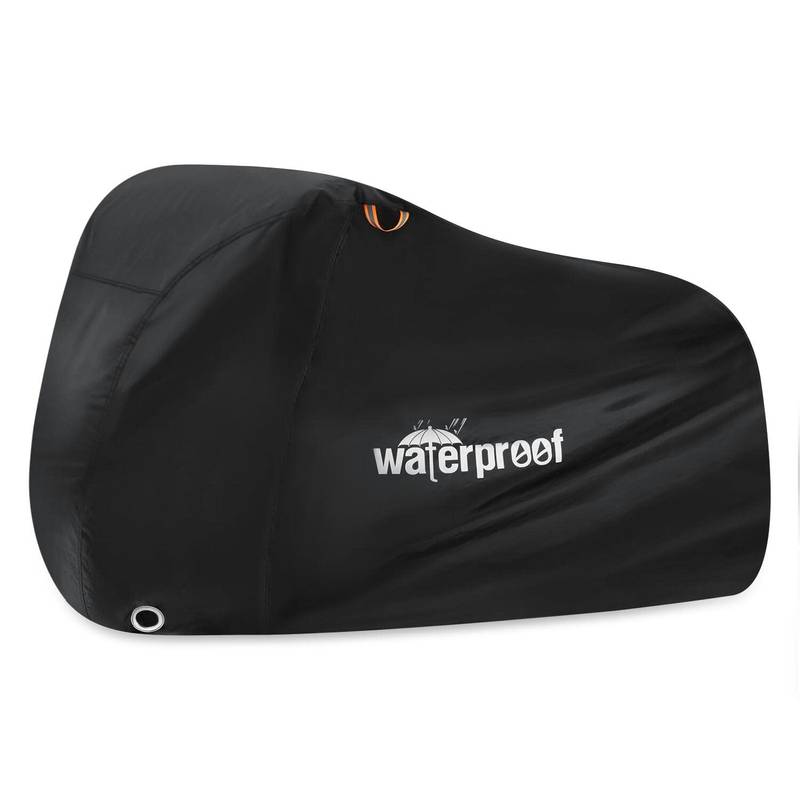
photo by Temu
Why its necessary to have
-
Protection from Weather: E-bikes have electronic components that are sensitive to moisture and extreme temperatures. A bike cover protects your e-bike from rain, snow, and sun exposure, reducing the risk of weather-related damage.
-
Dust and Debris Prevention: When parked outdoors or in a garage, a bike cover keeps your e-bike clean by shielding it from dust, dirt, and debris, which can accumulate in moving parts and affect the bike's performance.
-
Theft Deterrence: A covered bike is less noticeable and less likely to attract the attention of thieves. A bike cover can serve as a simple deterrent, adding an extra step for potential thieves.
-
Prolonging Lifespan: Regular exposure to the elements can accelerate wear and tear. By using a cover, you can prolong the lifespan of both the mechanical and electrical components of your e-bike.
-
Transportation: If you transport your e-bike on a vehicle rack, a cover can protect it from road grime and weather exposure during transit.
-
Maintaining Appearance: A cover helps maintain the appearance of your e-bike by preventing fading paint and other cosmetic damage caused by prolonged exposure to the elements.
-
Indoor Storage: Even when stored indoors, a cover can protect your e-bike from dust and accidental scratches.
How to choose the right one
-
Size and Fit: Ensure the cover is large enough to fit your eBike comfortably, including any additional accessories or protruding parts.
-
Material Quality: Look for durable, tear-resistant materials like polyester or nylon for longevity.
-
Waterproofing: Opt for a waterproof or water-resistant cover to protect against rain and moisture.
-
UV Protection: If you'll be storing the bike outside, choose a cover with UV protection to prevent sun damage.
-
Wind Resistance: Features like elastic hems or straps can help keep the cover secure in windy conditions.
-
Portability: Consider if the cover is lightweight and comes with a carrying case for ease of transport.
-
Ventilation: Good ventilation can prevent condensation and rust, especially important for eBikes with electrical components.
-
Security Features: Some covers have lock holes or cables for added security.
-
Ease of Use: The cover should be easy to put on and take off.
Alarm and GPS tracker
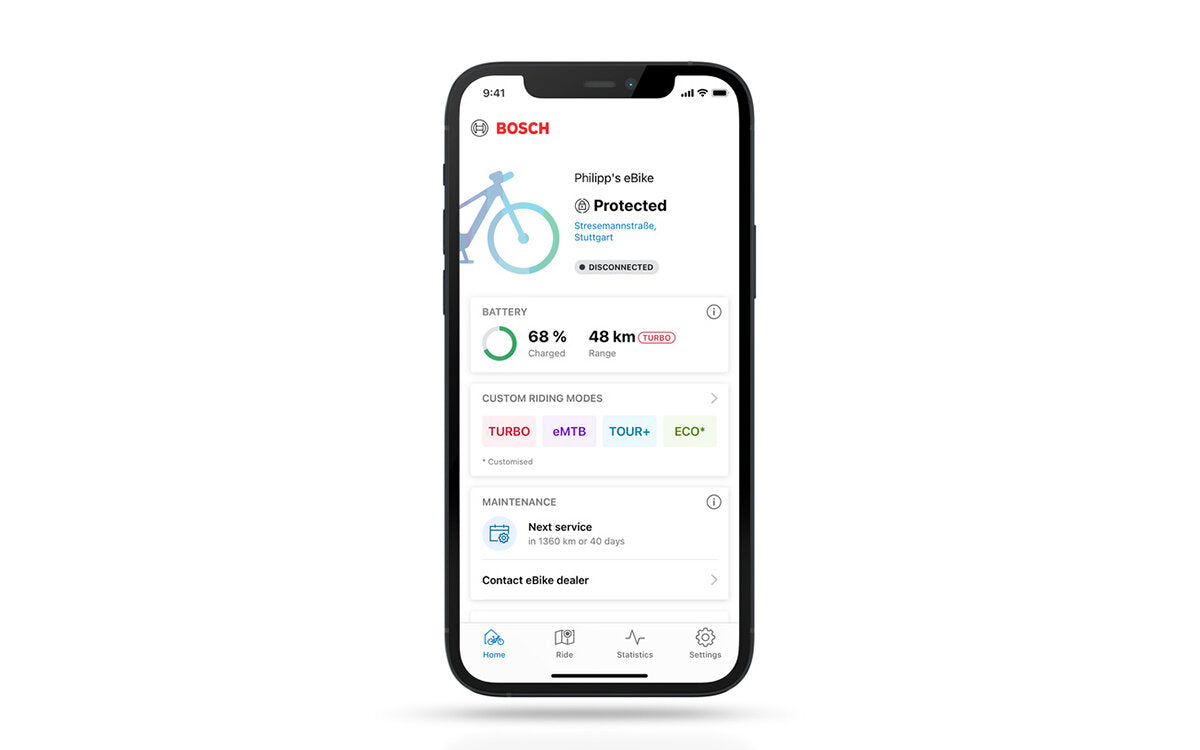
photo by bosch
Why its necessary to have
-
Theft Prevention and Deterrence: E-bikes, due to their value and popularity, are attractive targets for thieves. An alarm system can deter theft by emitting a loud sound when the bike is tampered with. GPS trackers add an extra layer of security, allowing you to track the location of your e-bike if it is stolen.
-
Recovery of Stolen E-bike: In the unfortunate event that your e-bike is stolen, a GPS tracker greatly increases the chances of recovery. You can provide the police with real-time location data to help track and recover your e-bike.
-
Peace of Mind: Knowing that your e-bike is equipped with an alarm and GPS tracker provides peace of mind, especially when you have to leave your e-bike unattended in public places.
-
Insurance Benefits: Some insurance companies offer reduced premiums for e-bikes equipped with anti-theft devices like alarms and GPS trackers, recognizing the reduced risk of theft.
-
Remote Monitoring: Advanced GPS trackers offer features like remote monitoring through a smartphone app, where you can check your e-bike’s location and receive alerts if it moves outside of a designated area.
-
Emergency Situations: Some GPS trackers come with additional safety features, such as sending an alert in case of an accident or when the rider has an emergency, making them useful for more than just anti-theft purposes.
-
Route Tracking for Personal Use: Besides security, GPS trackers can be used to record and analyze your riding patterns and routes, which can be enjoyable and useful for fitness tracking and route planning.
-
Increased Resale Value: Having a high-quality alarm and GPS tracker can increase the resale value of your e-bike, as it adds an appealing security feature for potential buyers.
How to choose the right one
-
Alarm Loudness: Select an alarm with a high decibel rating for effective deterrence.
-
Alarm Sensitivity Adjustment: Ability to customize sensitivity to avoid false alarms.
-
Alarm Installation Ease: Choose an alarm system that is straightforward to install on your eBike.
-
Tamper Alerts for Alarm: Look for features like motion sensors or shock detection for immediate alerts if the bike is disturbed.
-
Alarm Remote Control: An alarm with remote control for convenient activation and deactivation.
-
Real-Time GPS Tracking: Ensure the GPS tracker offers accurate, real-time location updates.
-
GPS Battery Life: Opt for a tracker with substantial battery life or one that integrates with your eBike's battery system.
-
GPS Geofencing Capability: The ability to set geographical boundaries and get alerts if the bike moves out of this area.
-
Tracker Size and Concealability: A compact, easily hidden tracker is less likely to be detected and removed.
-
Tracker Water Resistance: Important for durability, especially in various weather conditions.
-
GPS Subscription Fees: Be aware of any ongoing costs associated with the GPS tracking service.
-
Smart Device Compatibility: Check if the tracker's app or software works seamlessly with your smartphone or computer for monitoring.
Mudguards
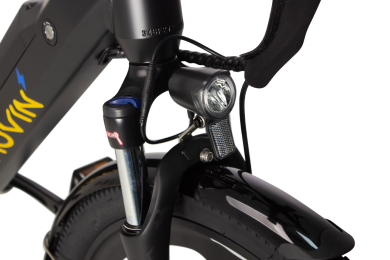
Why its necessary to have
-
Protection from Water and Mud: Mudguards protect you from splashes of water and mud when riding through wet or muddy conditions. This keeps your clothes and your bike cleaner, especially important if you're commuting or riding in your regular clothes.
-
Enhanced Comfort: By blocking water, mud, and debris from being flung up by the wheels, mudguards make your ride more comfortable, particularly in adverse weather conditions.
-
Protection for Your E-Bike: E-bikes have electrical components that could be sensitive to water and mud. Mudguards help to minimize the amount of debris that gets into these components, potentially prolonging the life of your e-bike.
-
Safety: Mudguards reduce the amount of spray that can obscure your vision while riding. For rear mudguards, this also means less spray for riders or vehicles behind you, enhancing overall safety on the road.
-
Maintenance Reduction: By keeping mud and grime away from the bike's components, mudguards can reduce the need for frequent cleaning and maintenance.
-
Aerodynamics: Some mudguards are designed to improve the aerodynamics of the bike, offering a slight advantage in terms of efficiency and speed, although this is more of a concern for performance cyclists.
-
Compliance with Local Regulations: In some regions, mudguards are required by law, especially for e-bikes used in urban commuting.
-
Respect for Fellow Cyclists and Pedestrians: Mudguards prevent the water and mud from being flung onto other cyclists or pedestrians, which is particularly important when riding in a group or in urban areas.
How to choose the right one
-
Compatibility with Bike: Ensure the mudguards fit your eBike's wheel size and frame design.
-
Coverage: Full-length mudguards offer more protection against spray and mud, while clip-on guards are more flexible and easier to install.
-
Material: Look for durable materials like plastic, polycarbonate, or metal that can withstand regular wear and tear.
-
Installation: Consider how easy it is to install or remove the mudguards. Some require tools, while others are tool-free.
-
Weight: Opt for lightweight mudguards to minimize the additional weight on your eBike.
-
Width: Ensure the mudguards are wide enough for your tires. Wider tires require wider mudguards.
-
Aesthetics: Choose mudguards that match your eBike's style and color scheme.
-
Adjustability: Adjustable mudguards can be fine-tuned for optimal protection and clearance.
Car Rack for Bike
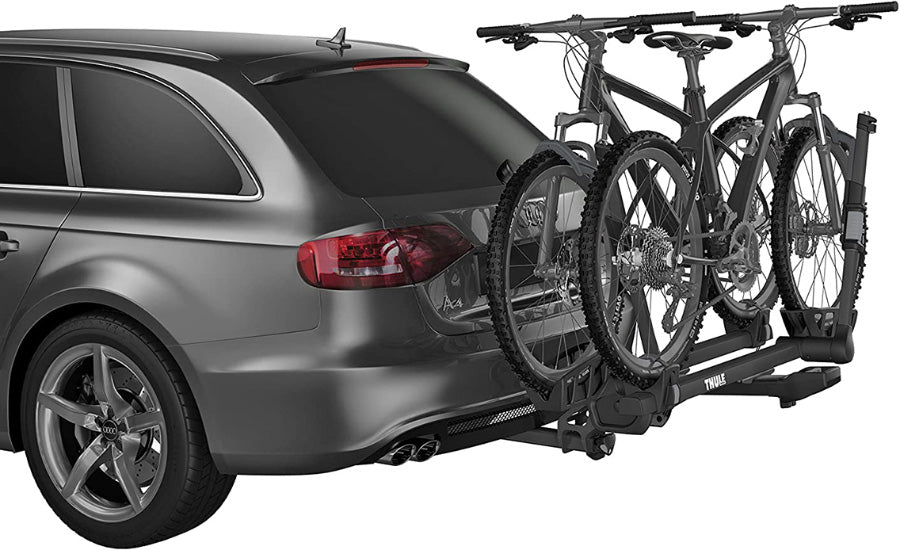
photo by electric bike report
Why its necessary to have
-
Transportation Convenience: A car rack allows you to easily transport your e-bike to different locations. This is particularly useful if you want to ride in areas that are not easily accessible from your home, like distant trails, scenic routes, or specific cycling destinations.
-
E-Bike Weight and Size: E-bikes are generally heavier and sometimes bulkier than traditional bicycles due to their motor and battery. A car rack designed for e-bikes can accommodate this extra weight and size, making transportation safer and more convenient.
-
Preserving Energy for Your Ride: Transporting your e-bike using a car rack saves the bike's battery power for your ride, rather than using it up to get to your starting point.
-
Safety: Transporting an e-bike inside a vehicle can be challenging and potentially unsafe due to its size and weight. A car rack ensures that the bike is securely attached to the exterior of the vehicle, reducing the risk of damage to both the bike and the car's interior.
-
Long-Distance Travel: If you’re traveling long distances by car and plan to use your e-bike at your destination, a car rack is essential for bringing your bike along.
-
Accessibility: For riders who live in urban areas or places where off-road trails and cycling paths are not nearby, a car rack allows for easy access to more varied and suitable riding locations.
-
Reducing Wear and Tear on the Bike: Using a car rack to transport your e-bike can reduce wear and tear that might occur if you rode it long distances on hard surfaces to reach your preferred cycling destination.
-
Group Rides and Events: If you participate in group rides or cycling events that start at a specific location, a car rack is necessary for transporting your e-bike to the meeting point.
How to choose the right one
-
Rack Type:
- Hitch-mounted Racks: Stable and easy to load; require a hitch on your car.
- Trunk-mounted Racks: Portable and generally more affordable; may not support heavier eBikes.
- Roof-mounted Racks: Good for lighter eBikes; ensure your vehicle’s roof can support the weight.
-
Weight Capacity: eBikes are heavier than regular bikes, so ensure the rack can support the weight of your eBike(s).
-
Bike Compatibility: Check that the rack fits your eBike's frame design, tire size, and wheelbase.
-
Ease of Loading: Consider how easy it is to load and unload your eBike, especially important due to their weight.
-
Security Features: Look for racks with built-in locks or secure attachment points to protect against theft.
-
Vehicle Compatibility: Ensure the rack is compatible with your vehicle model and doesn't obstruct rear visibility or access.
-
Durability and Build Quality: Choose a rack made from robust materials to withstand regular use and outdoor conditions.
-
Portability and Storage: Consider how easily the rack can be stored when not in use. Foldable designs can be more convenient.
Kickstand
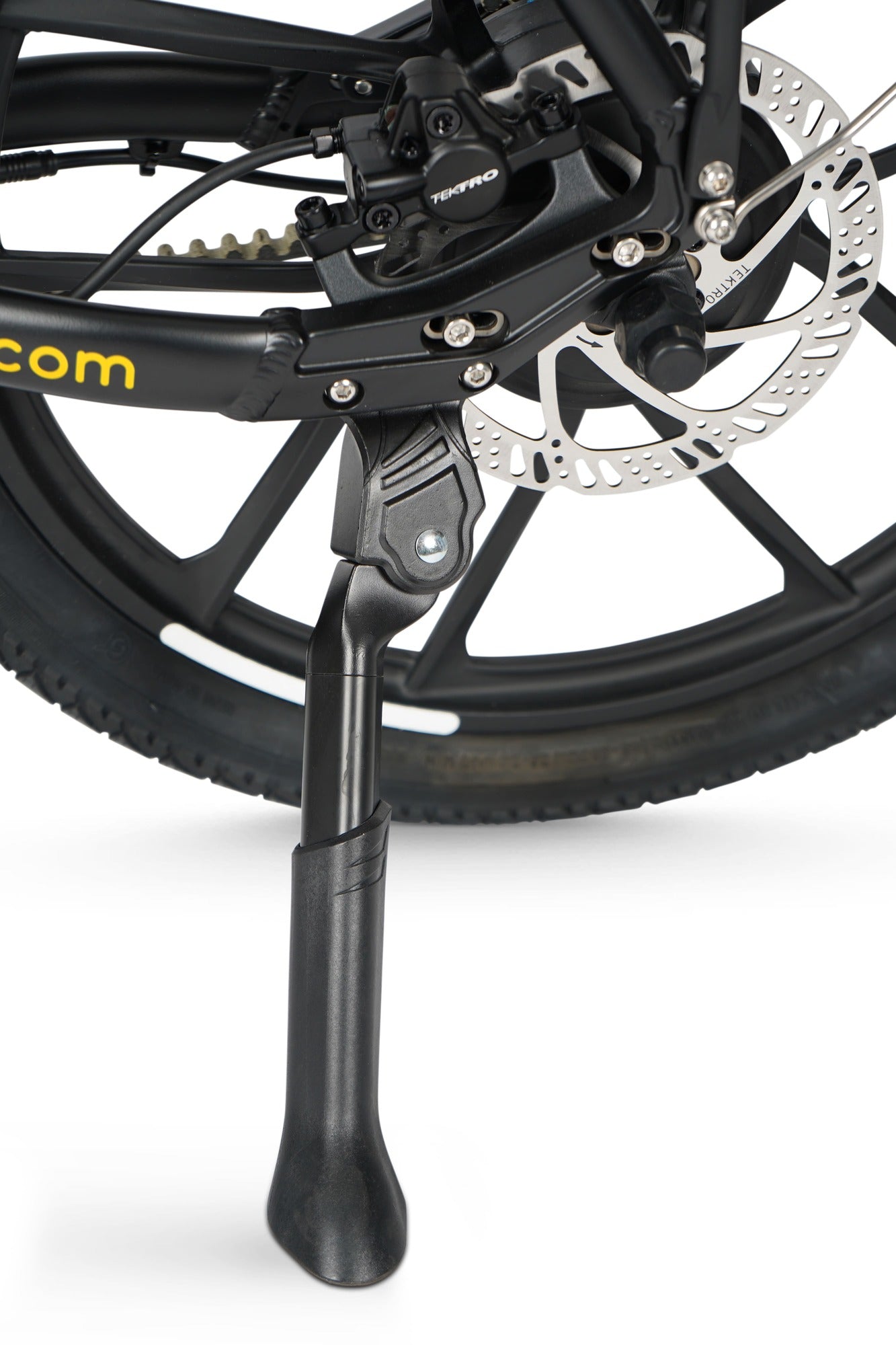
Why its necessary to have
-
Convenience in Parking: A kickstand allows you to park your e-bike upright anywhere, which is especially convenient when bike racks or other secure parking options are not available.
-
Stability: E-bikes are heavier than traditional bicycles due to their motor and battery. A sturdy kickstand can safely support this extra weight, providing stable and reliable parking.
-
Ease of Loading and Unloading: When using panniers, baskets, or loading other cargo onto your e-bike, a kickstand keeps the bike steady and upright, making it easier and safer to load and unload items.
-
Maintenance and Cleaning: A kickstand allows you to prop up your e-bike for basic maintenance tasks, adjustments, or cleaning without needing a separate bike stand.
-
Preventing Damage: Leaning an e-bike against a wall or other surfaces can scratch or damage the bike’s frame or components. A kickstand prevents such damage by keeping the bike upright and secure.
-
Convenient for Short Stops: For quick stops, like checking your map or taking a short break, a kickstand is a handy feature that saves time and effort.
-
E-bike Specific Design: Some kickstands are specifically designed for the weight distribution and design of e-bikes, ensuring that the bike remains stable and secure when parked.
-
Protection of Electrical Components: Proper parking using a kickstand helps prevent accidental damage to the e-bike's electrical components, which might occur if the bike is improperly leaned or falls over.
How to choose the right one
-
Compatibility with eBike: Ensure the kickstand fits your eBike's frame size and type.
-
Weight Capacity: eBikes are heavier than regular bikes, so choose a kickstand that can support the additional weight.
-
Adjustability: Opt for a kickstand that allows height adjustment for stability on various surfaces.
-
Material Quality: Look for durable materials like aluminum or steel for strength and longevity.
-
Installation: Check how the kickstand attaches to the bike and ensure it's easy to install with minimal tools.
-
Stability: The kickstand should provide a stable and secure base when parked, especially when loaded with gear.
-
Foot Design: A wider foot prevents sinking on soft surfaces and offers better support.
-
Clearance and Interference: Ensure the kickstand doesn't interfere with pedal movement or the bike's drivetrain.
Derailleur Guard
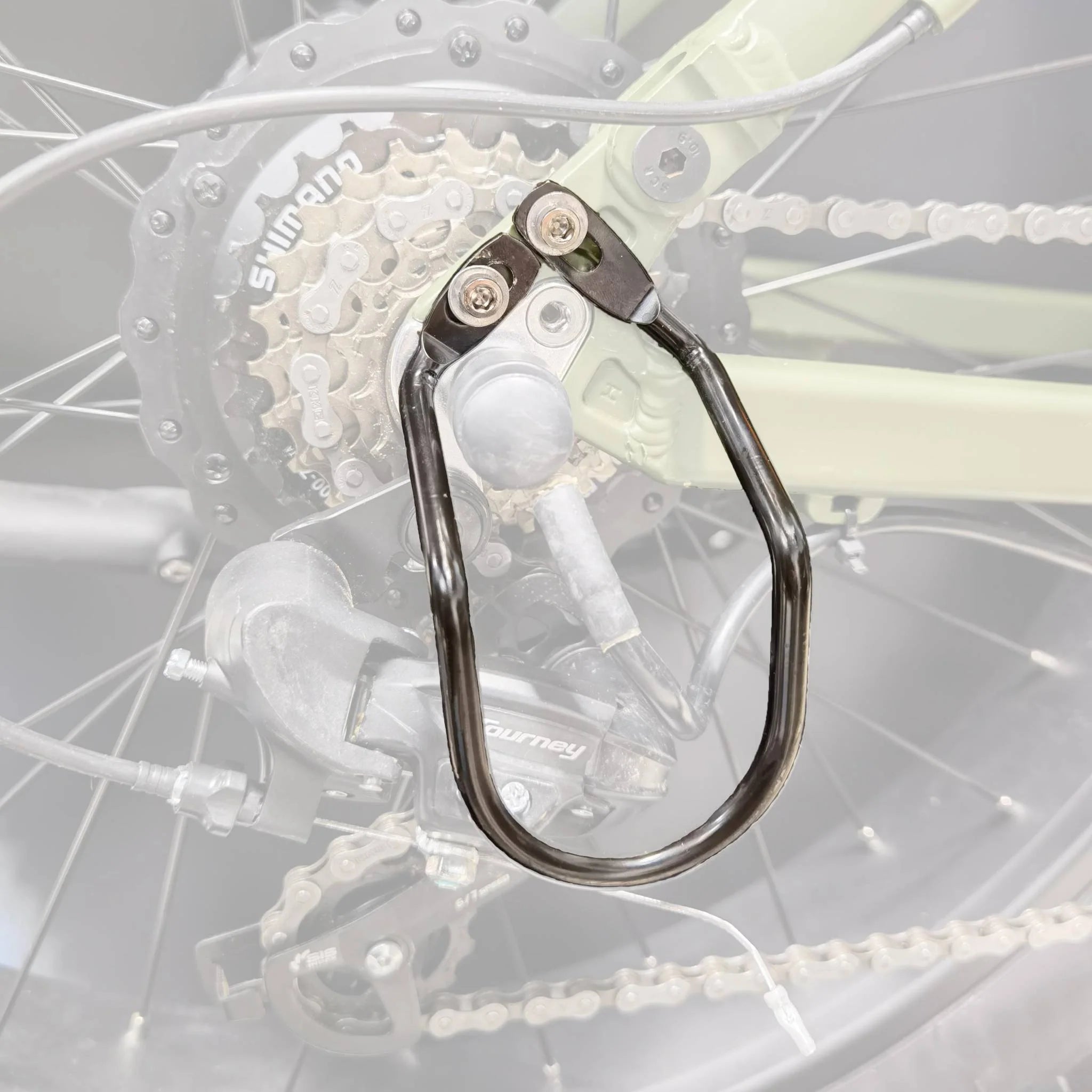
photo by beecoolbikes
Why its necessary to have
-
Protection from Impacts: The derailleur is a vital component of your e-bike's drivetrain, but it's also relatively exposed and vulnerable to damage. A guard shields it from impacts, such as those from rocks, debris, or in the event of a fall, helping to prevent bending or breaking.
-
Maintaining Gear Functionality: Damage to the derailleur can affect shifting performance and the overall functionality of your gears. A guard helps ensure that your drivetrain stays in good working order, providing a smoother and more reliable riding experience.
-
Reduced Maintenance Costs: Protecting the derailleur can save on maintenance and repair costs. Derailleurs can be delicate and expensive to repair or replace, so a guard is a cost-effective measure to prolong its lifespan.
-
E-Bike Specific Needs: E-bikes often travel faster and may be used on a variety of terrains, increasing the risk of impacts that could damage the derailleur. A guard provides extra protection suited to these conditions.
-
Enhanced Off-Road Riding: If you use your e-bike for off-road riding, a derailleur guard is particularly beneficial as it protects against the rougher terrain and debris typically encountered in such environments.
-
Longevity of the Bike: Keeping key components like the derailleur in good condition helps maintain the overall longevity and resale value of your e-bike.
-
Peace of Mind: Knowing that your derailleur is protected allows you to focus more on your ride and less on avoiding potential damage, especially in challenging riding conditions.
How to choose the right one
-
Compatibility with eBike Model: Ensure the guard fits your eBike's specific model and derailleur type.
-
Material Strength and Durability: Look for guards made from strong, durable materials like steel or hardened aluminum that can withstand impacts.
-
Coverage and Protection: Choose a guard that provides ample coverage to shield the derailleur from direct hits and debris.
-
Weight: Consider the weight of the guard; heavier guards offer more protection but add more weight to your eBike.
-
Installation Ease: Opt for a guard that can be easily installed and removed without requiring extensive modifications to your bike.
-
Aesthetics: Consider a guard that complements the style and color of your eBike.
-
Clearance and Accessibility: Make sure the guard does not interfere with the derailleur's function and allows easy access for maintenance.
Battery Cover
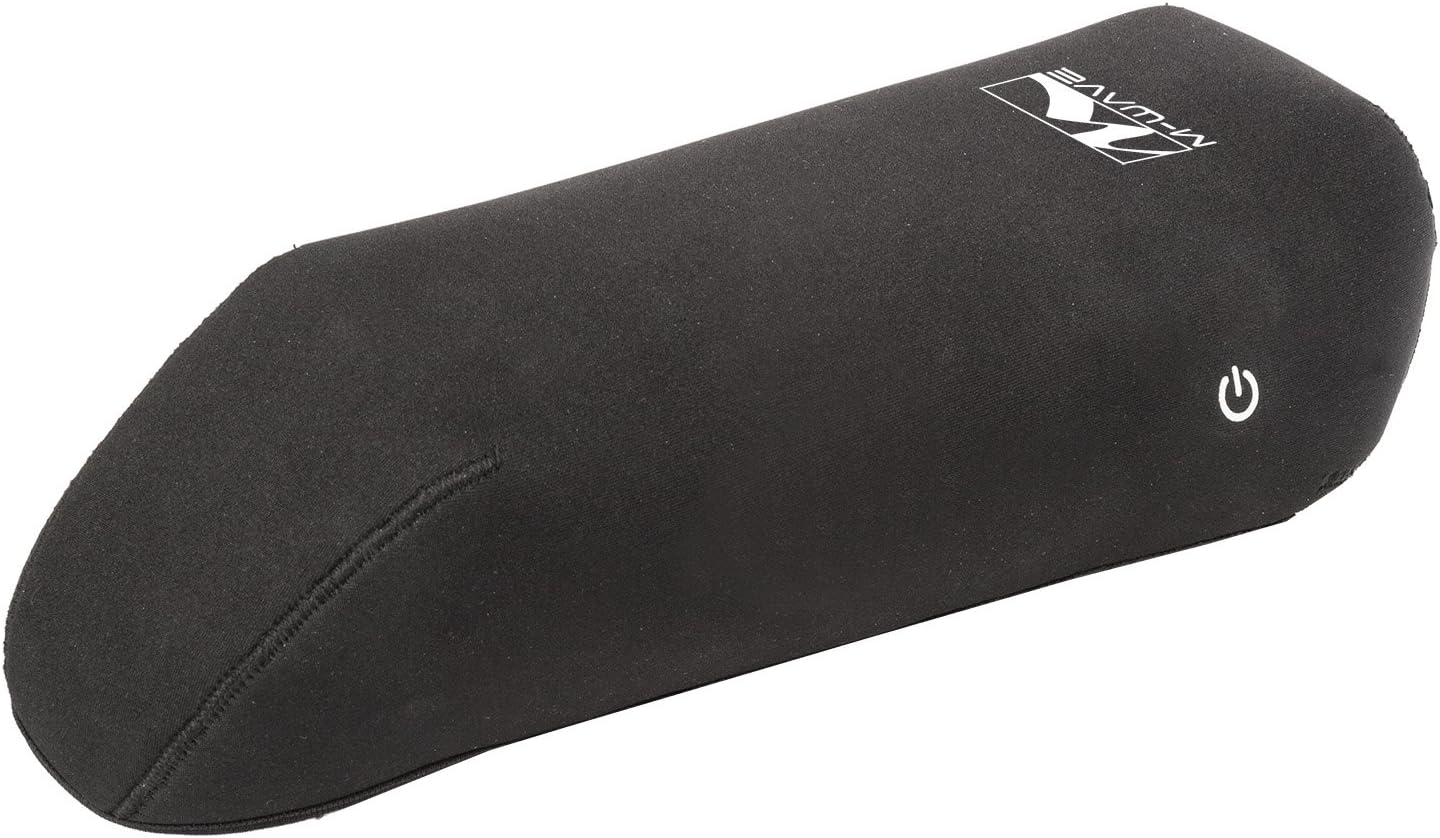
Why its necessary to have
-
Protection from the Elements: The battery is one of the most crucial components of your e-bike, and it's sensitive to extreme temperatures, water, and dirt. A battery cover helps protect it from rain, snow, and road debris, prolonging its lifespan.
-
Thermal Insulation: In cold weather, battery performance can significantly decrease, reducing the range of your e-bike. A cover can provide thermal insulation, helping to maintain the battery's optimal operating temperature and ensuring more consistent performance.
-
Preventing Impact Damage: A cover can add an extra layer of protection against impacts and scratches, which can occur if the bike falls over or brushes against objects.
-
Security: A battery cover can also serve as a layer of security. It makes the battery less visible and accessible, potentially deterring theft.
-
Aesthetic Integration: Some battery covers are designed to seamlessly integrate with the frame of the e-bike, enhancing its overall appearance and aerodynamics.
-
Preserving Resale Value: Protecting the battery from wear and tear can help maintain the resale value of your e-bike, as the battery is a key component that potential buyers will inspect.
-
Convenience: Covers designed for easy removal and attachment make it more convenient to charge the battery, either on or off the bike
How to choose the right one
-
Compatibility with Battery Size and Shape: Ensure the cover fits your specific eBike battery model snugly and securely.
-
Material Quality: Look for durable, insulating materials that offer protection against cold, heat, and moisture, such as neoprene or other weather-resistant fabrics.
-
Thermal Insulation: A cover with good thermal insulation can improve battery performance in extreme temperatures.
-
Ease of Access: The cover should allow easy installation and removal of the battery for charging or maintenance.
-
Water Resistance: Opt for a cover that provides adequate protection against rain and splashes, especially if you ride in varied weather conditions.
-
Aesthetic Appeal: Consider a cover that matches or complements the style of your eBike.
-
Cutouts and Ventilation: Ensure the cover has proper cutouts for any charging ports or ventilation required for the battery.
Extra Charger
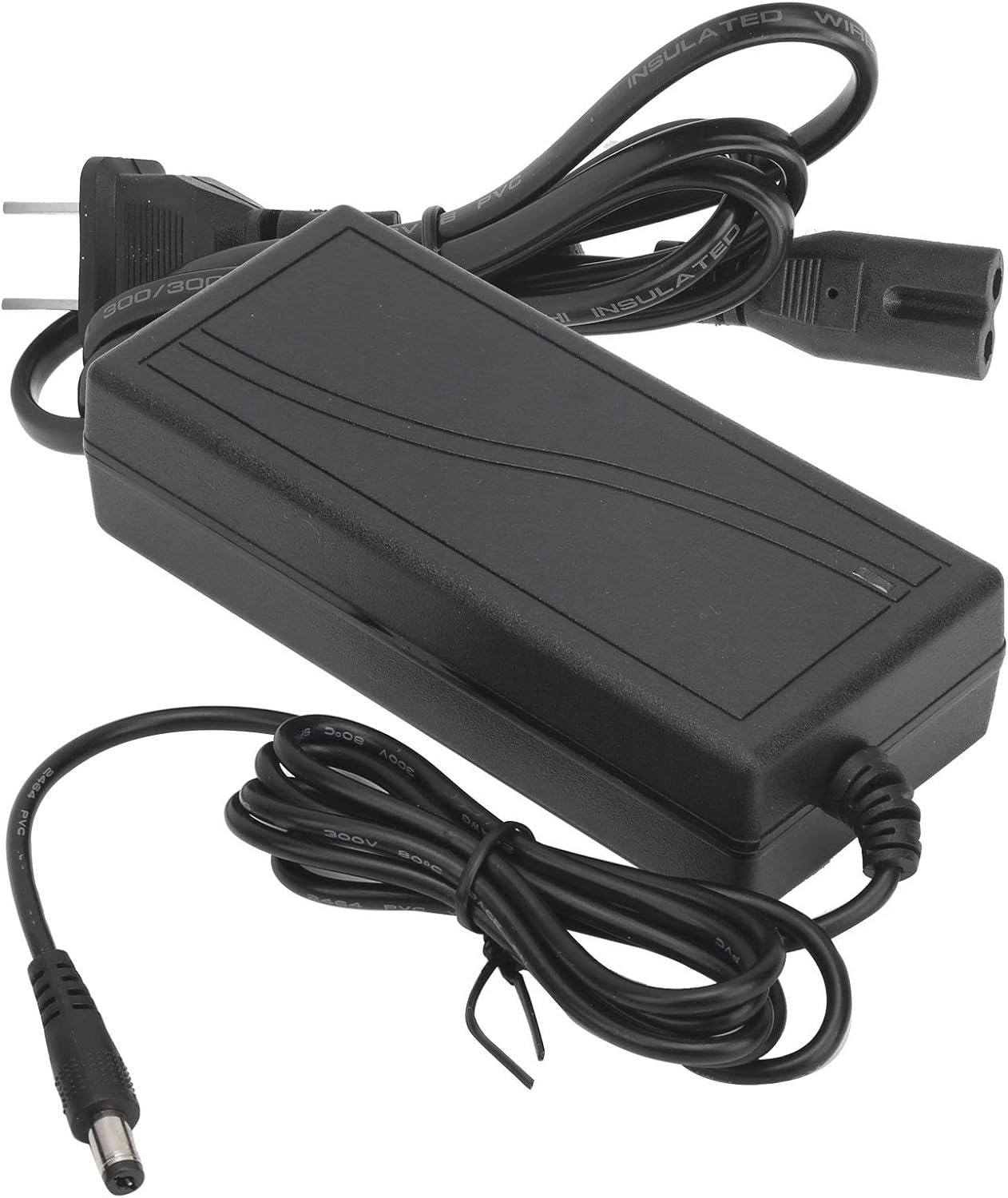
photo by amazon
Why its necessary to have
-
Convenience: Keeping an extra charger at a location where you spend a lot of time, like your workplace or a second home, means you don't have to carry the charger back and forth. This is especially convenient if the charger is bulky or heavy.
-
Extended Range: If you plan on riding long distances and have access to a power source along your route, having an extra charger allows you to recharge the battery during stops. This effectively extends the range of your e-bike, making longer trips more feasible.
-
Backup in Case of Failure: Chargers can malfunction or get damaged. Having a spare ensures that you can still charge your e-bike if your primary charger is not working.
-
Reduced Downtime: If you forget your primary charger somewhere, having an extra charger means you won’t have to wait until you retrieve it to charge your e-bike, reducing downtime.
-
Flexibility in Charging Locations: With an extra charger, you have the flexibility to charge your e-bike in different locations without the hassle of unplugging and carrying your only charger with you everywhere.
-
Emergency Preparedness: In case of emergencies where you need to use your e-bike and your primary charger is inaccessible or left at a different location, having an extra charger can be a lifesaver.
How to choose the right one
-
Compatibility with Battery: Ensure the charger is compatible with your eBike's specific battery type and voltage.
-
Charging Speed: Consider the charging time. Faster chargers can be more convenient but may affect battery longevity.
-
Portability: If you need to carry the charger, opt for a compact and lightweight design.
-
Connector Type: The charger should have the correct connector for your eBike's battery.
-
Quality and Safety Features: Look for chargers with safety features like overcharge protection, short-circuit protection, and temperature control.
-
Manufacturer or Brand: Preferably use a charger from the same manufacturer as your eBike for assured compatibility and safety.
-
Input Voltage Range: If you travel, ensure the charger can handle varying input voltages (e.g., 110V and 220V).
Bike Trailer
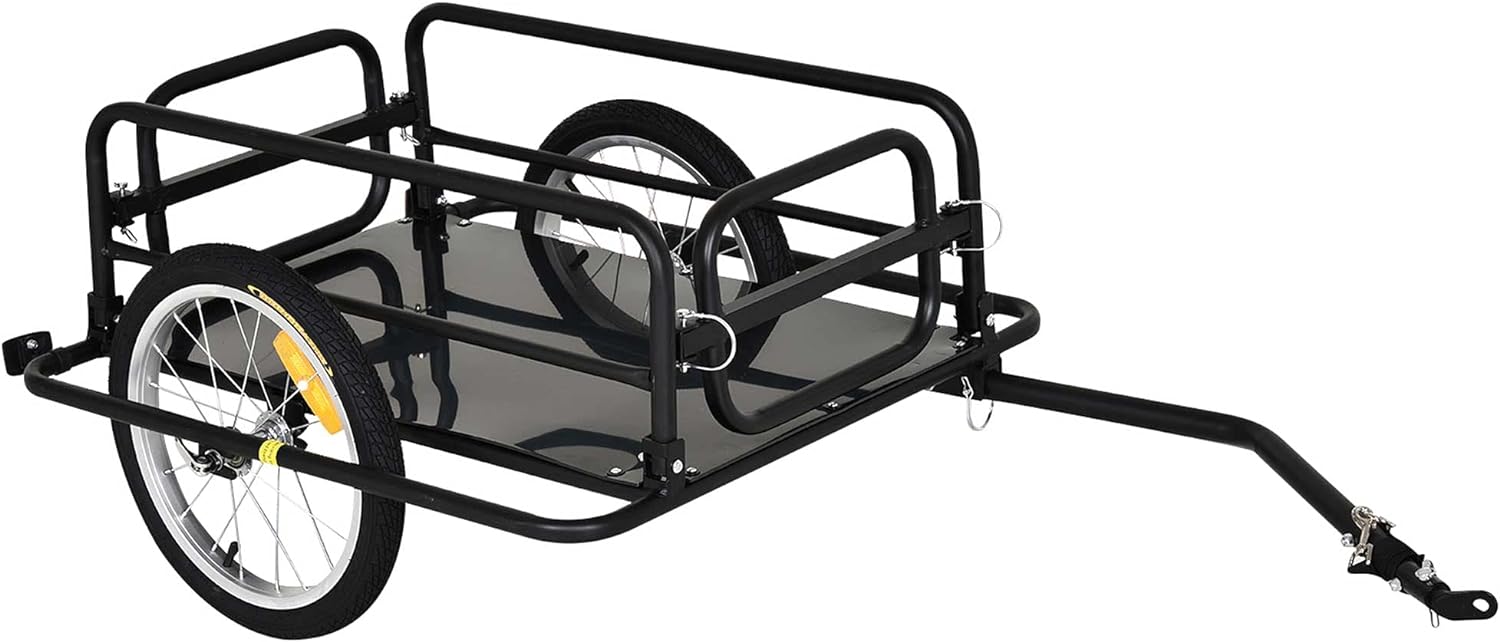
photo by amazon
Why its necessary to have
-
Increased Cargo Capacity: A bike trailer significantly increases the amount of cargo you can carry. This is ideal for grocery shopping, running errands, or carrying equipment for activities like camping or fishing.
-
Child Transportation: If you have young children, a bike trailer designed for child transportation provides a safe and enjoyable way for them to accompany you on rides. These trailers are equipped with safety harnesses and protective coverings.
-
Pet Transport: For pet owners, a bike trailer can be outfitted to safely transport pets, allowing them to join on rides without the strain or danger of running alongside the bike.
-
E-Bike Power Assistance: The additional power from an e-bike's motor makes towing a trailer more feasible than with a traditional bike, especially when carrying heavy loads or traveling uphill.
-
Utility for Commuting or Business: For commuters or small business owners, a trailer can be a practical solution for transporting work equipment, deliveries, or personal belongings.
-
Recreational and Touring Use: For recreational riders or those on bike tours, trailers offer the space to carry camping gear, food, and other supplies needed for extended trips.
-
Environmentally Friendly Transportation: Using an e-bike with a trailer for cargo or passenger transport is an eco-friendly alternative to using a car, reducing carbon emissions and traffic congestion.
-
Safety and Stability: Modern bike trailers are designed for stability and safety, with features like flagpoles for visibility and suspension systems for a smooth ride.
How to choose the right one
-
Purpose and Use: Determine whether the trailer will be used for carrying cargo, children, pets, or a combination of these.
-
Compatibility with eBike: Ensure the trailer hitch is compatible with your eBike’s design and model.
-
Weight Capacity: Check the maximum weight capacity of the trailer, especially important for eBikes due to their additional power.
-
Size and Storage: Consider the size of the trailer and whether it fits your storage needs and space constraints.
-
Safety Features: For passenger trailers, look for features like a sturdy harness, protective canopy, and safety flags. Reflective elements and lights are essential for visibility.
-
Durability and Material: Opt for robust materials and construction, especially if you plan to carry heavy loads or use the trailer frequently.
-
Wheel Type and Suspension: Larger wheels and suspension systems offer better stability and comfort, especially on uneven terrains.
-
Ease of Assembly and Disassembly: A trailer that's easy to attach and detach adds convenience.
-
Foldability and Portability: If space is a concern, consider a foldable design for easy storage and transport.
Also you can find more useful info about
Conclusion
Choose accessories wisely. Always pay attention to wear resistance and crash tests. Many accessories only look nice but become unusable after a couple of months. Come visit us at and we will give you special promo codes for discounts from our partners who have a wide range of branded accessories.
We are in Movin Ebikes have all necessary accessories that will help you enjoy your rides. Equip your bike and become a professional rider!
